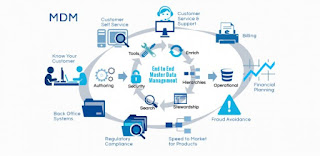Catapulting the Significant Features of Product Master Data Management Solutions for Business Enterprises
Product
master data management can be defined as the practice of using information, applications and
other technology to effectively support product-related processes across the
customer, commerce and supply chain.
As organizations increase the number and
diversity of products and services they offer to customers and partners, they
increasingly need to address limitations in the ways they manage and distribute
product information, including related attributes and content that describes
the products.
PIM solutions, the applications and technology which
help implementing it are designed to help businesses provide the best possible
product data across all the channels, departments and partners across their
enterprise. To accomplish this, your product
information management software must support multiple business
roles, from product managers and marketers to operations and manufacturing
teams and to suppliers and those in the supply chain.
Effectively managed product data is extremely
essential for taking informed decisions about the retail, distribution,
manufacturing and marketing of products and services further. Analytics applied
to product information can yield a variety of metrics; they can indicate where
product information is missing, where it needs to be improved, patterns of
product usage and the meaning of feedback about them.
Unveiling the Significant
Features of Product Information Management Software:
- Flexible Data Model: Systems that promise a perfect in-built data model work only if the system and data landscape of the business in question is tightly coupled with that data model. Most companies don't stick to a system data model but require flexibility in terms of structure, attribution and data quality rules.
- Audit Trail: MDM adoption by the business translates to building a platform they can trust. They need to understand why the data was updated from A to B versus blindly trusting a MDM tool. Audit trail provides the details around all the changes the data goes through and why.
- Matching & Merging: Although these are two separate features they go hand-in-hand. Duplication being the biggest problem for businesses matching duplicate records based on custom business rules and merging the duplicate records (preferably guided where you get to choose attributes between the duplicate records) are must have features.
- Automerge: There should be a capability for systematic automerge for duplicate records if all the set criteria are met.
- Case Management/Queue Management: More often than not data stewards will need to look at the data tagged with data quality problems to ensure that its truly a data or duplication problem and then accept reject the changes. Some of the other important features are - cost, product maturity, product implementations in your vertical, integrator you use, product reliability, technical support, time-to-value, alignment with client's existing architecture, your Architect or decisions makers favourite vendor (believe me this happens a lot), availability and cost of technical resources to implement and support the application post implementation, etc.
The recent emphasis on regulatory compliance,
SOA, and mergers and acquisitions has made the creating and maintaining of
accurate and complete master data a business imperative. Both large and small
businesses must develop data-maintenance and governance processes and
procedures, to obtain and maintain accurate master data for the smooth and
hassle free working of the organization and to attain the highest degree of
customer satisfaction.
So, why wait? Choose
and install the best product
information management solution for your business enterprise to store, access,
allocate and use your important product data in a systematic manner, NOW!






Comments
Post a Comment